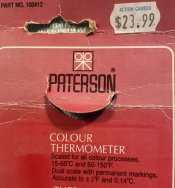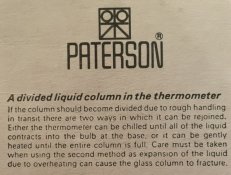DREW WILEY
Member
- Joined
- Jul 14, 2011
- Messages
- 14,144
- Format
- 8x10 Format
Well, Kodak probably never made it themselves, but subcontracted the manufacture to a specialty supplier having that kind of capability. I like to buy lifetime-quality gear whether for the darkroom or the shop, and long ago discovered that the best gear nearly always turns out to be the cheapest in the long run, as well as the most productive. Now I'll admit that not everyone can drop $250 or $300 on a new glass thermometer. But I've seen surplus unused Kodak Process ones turn up as low as $50.












 ) one for non-photographic purposes, and I use that as a reference for the cheaper thermometers I actually use for photo stuff (several Patersons). They are all +/- a few 10ths of a degree C and that is plenty good for black and white photography. Color processing is more sensitive but I don’t know what level of accuracy is needed.
) one for non-photographic purposes, and I use that as a reference for the cheaper thermometers I actually use for photo stuff (several Patersons). They are all +/- a few 10ths of a degree C and that is plenty good for black and white photography. Color processing is more sensitive but I don’t know what level of accuracy is needed.